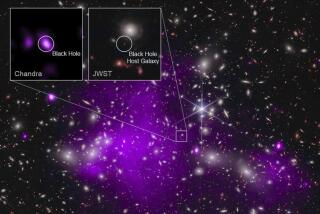Scientists discover two new particles at Large Hadron Collider
Welcome to the family! Scientists using CERN’s Large Hadron Collider in Europe have discovered two new subatomic particles.
The discovery of the two related particles, submitted to the journal Physical Review Letters, fills in missing slots in the subatomic roster that had been predicted but never seen.
“It’s reassuring,” said study coauthor Matthew Charles, a particle physicist at the French National Center for Scientific Research’s LPNHE laboratory at the University of Paris VI. “Not only did we find them but we got to make very precise measurements of their properties, in particular their masses.”
The two new members of the subatomic family, known as Xi_b’- and Xi_b*-, are baryons. Baryons, a group that includes protons and neutrons, are made up of three even tinier building blocks, called quarks. Quarks come in different “flavors” -- up, down, strange, charm, bottom and top. (And yes, those really are actually the names of these quarks.)
In different combinations and configurations, quarks can build very different types of baryons. (For example: Protons are made of two up quarks and one down quark; neutrons are made of one up quark and two down quarks.)
These particular particles, Xi_b’- and Xi_b*-, are both made of a “beauty” quark, a strange quark and a down quark. The super-heavy beauty quarks, also known as bottom quarks, give the new baryons their formidable mass: more than six times that of their fellow baryon the proton.
While the two new baryons have the same quarks as each other, they’re in slightly different configurations, which gives them slightly differing properties. In the Xi_b’- particle, the “spins” of its two lighter quarks (the strange and the down quarks) are pointed opposite each other. But in the Xi_b*- particle, the spins of those two quarks are aligned, which gives this particle a little extra energy – and makes it a little heavier. Xi_b’- weighs in at 5,935 mega-electron volts, while Xi_b*- tips the scales at 5,955 mega-electron volts.
The discovery, made by the Large Hadron Collider beauty experiment team, or LHCb, was pulled from data taken in 2011 and 2012 at the collider near Geneva, Switzerland. When the giant, ring-shaped collider smashes proton beams together, scientists sift through the resulting shower of subatomic detritus for signs of specific, long-predicted particles.
Even so, trying to pull the right signal out of that shower of stuff can be like picking a needle out of a haystack. So the researchers were pleased when they found clear signs that the two newly discovered baryons had been produced.
“As soon as we actually looked at the data, they immediately jumped right out. There’s absolutely no question,” Charles said. “That was a very nice surprise.”
What’s your favorite subatomic particle? Follow @aminawrite for more science news.







